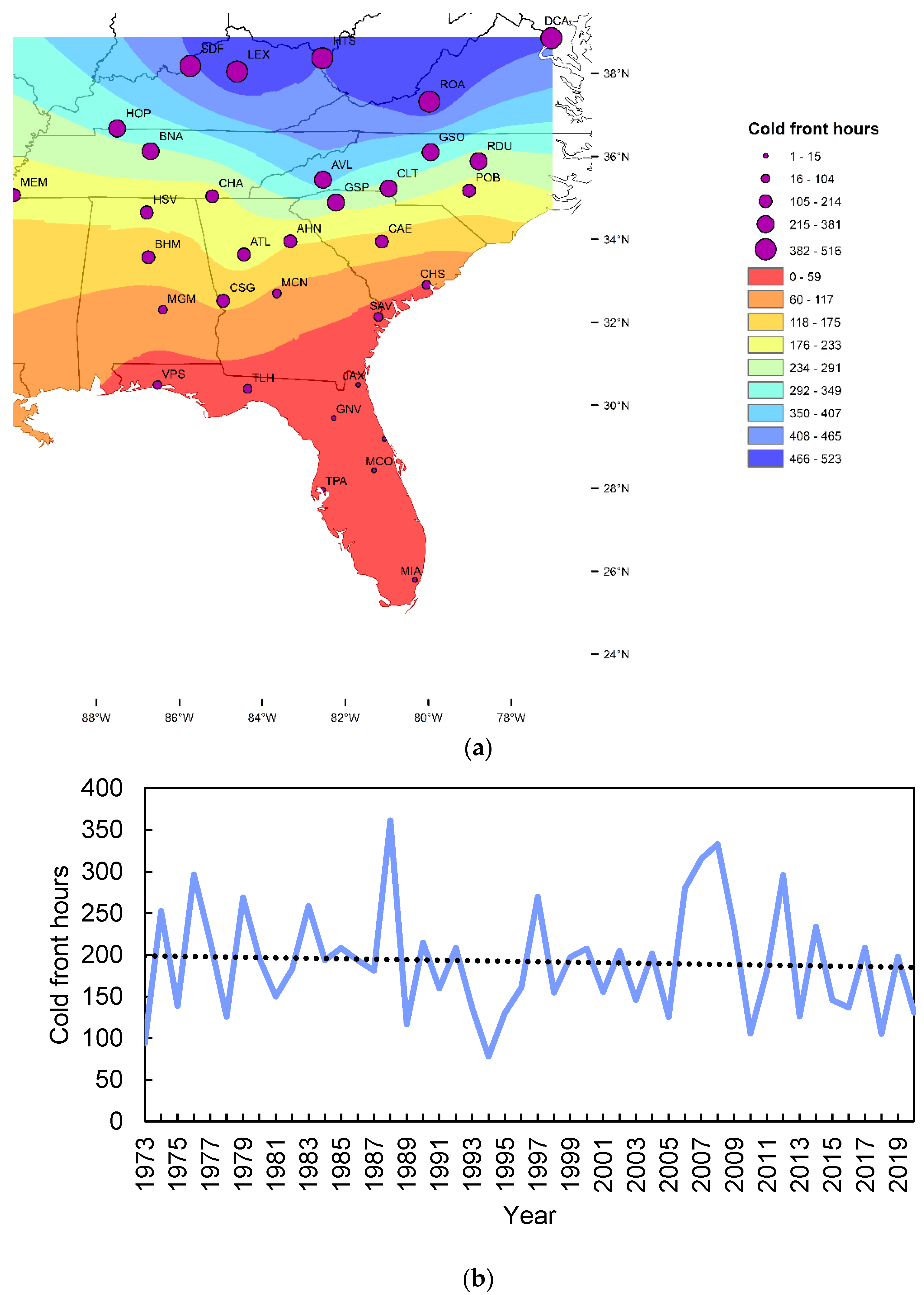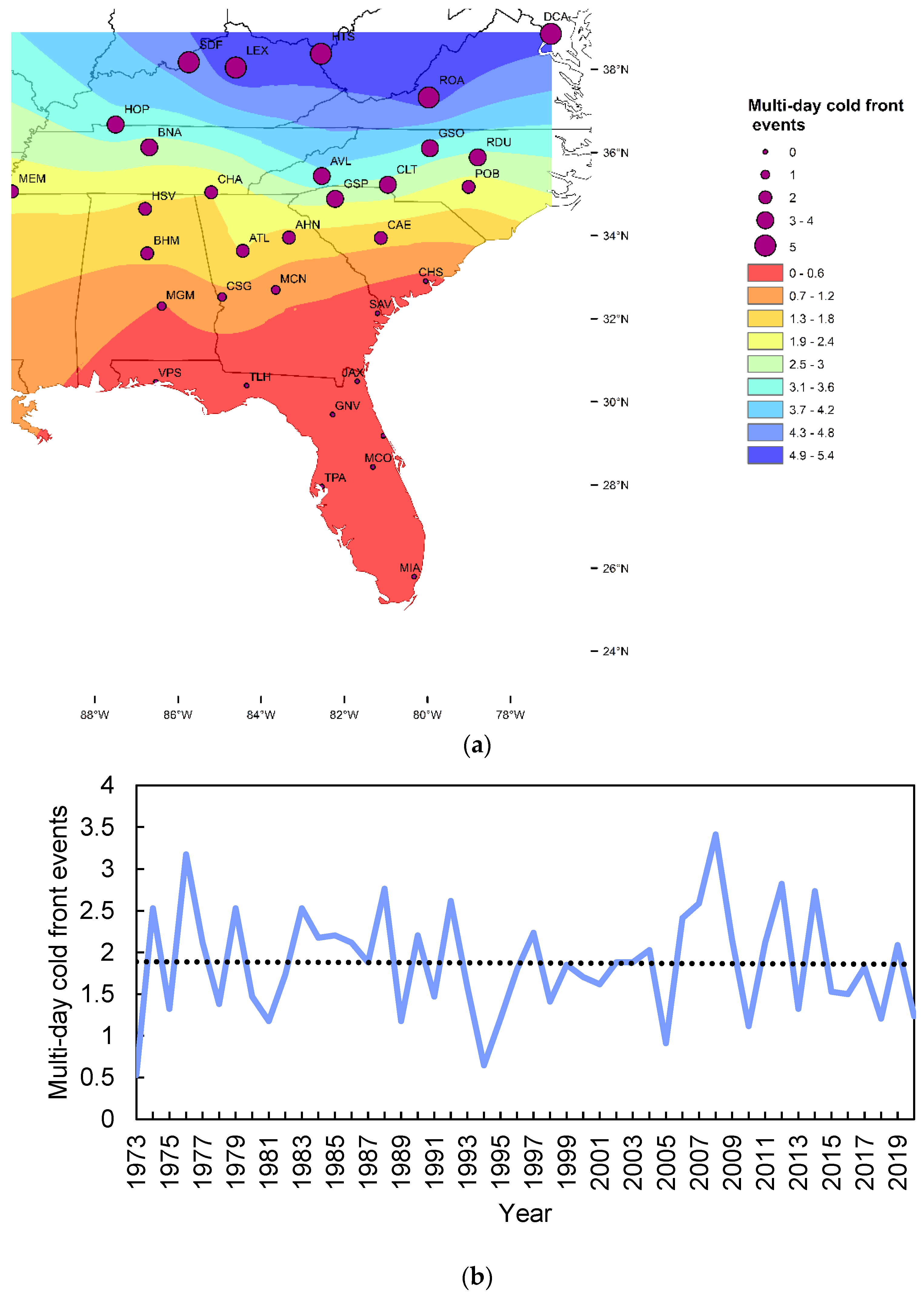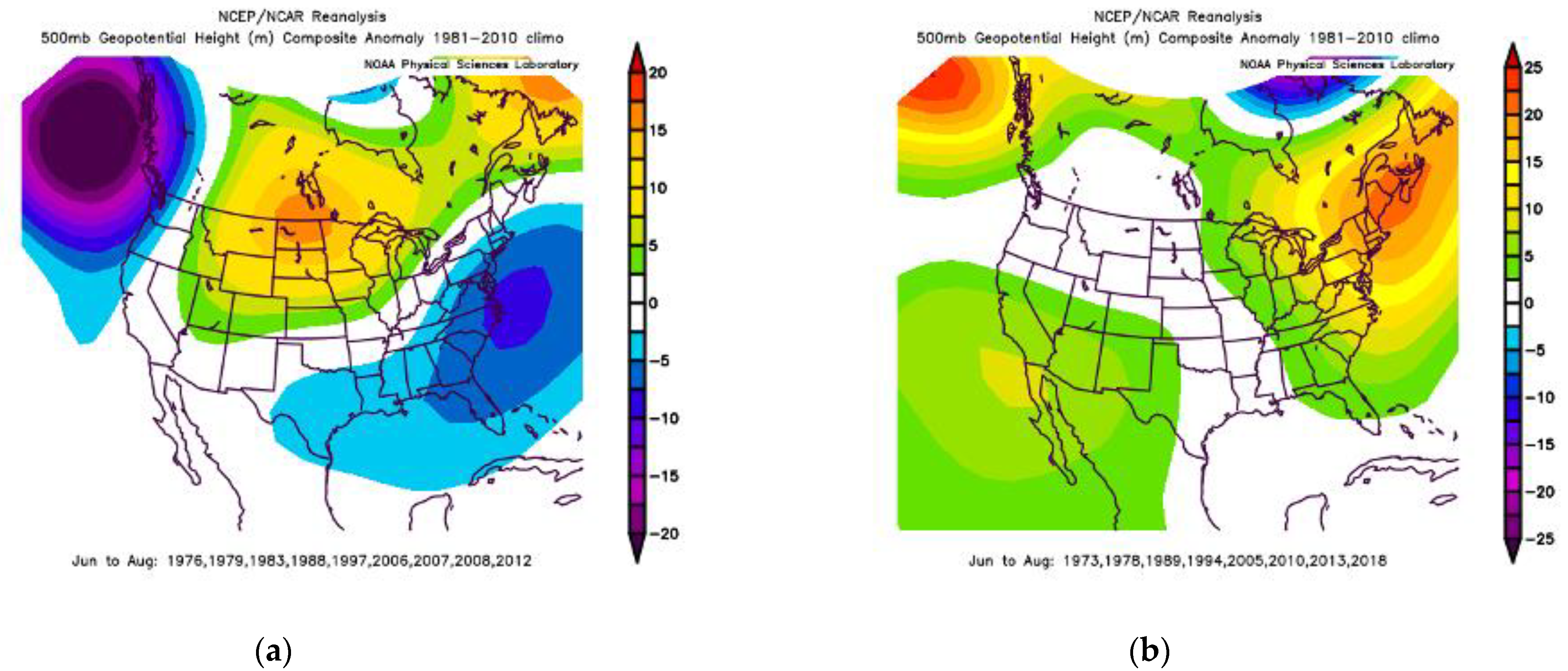Observations on the Frequency, Duration, and Geographical Extent of Summertime Cold-Front Activity in the Southeastern USA: 1973–2020
Abstract
:1. Introduction
2. Materials and Methods
2.1. Climate Data
2.2. Mapping
2.3. Synoptic Data
3. Results and Discussion
3.1. Cold Front Hours
3.2. Cold-Front Days
3.3. Multi-Day Cold-Front Events
3.4. Synoptic Controls
4. Conclusions
Supplementary Materials
Author Contributions
Funding
Acknowledgments
Conflicts of Interest
References
- Neukom, R.; Steiger, N.; Gómez-Navarro, J.J.; Wang, J.; Werner, J.P. No evidence for globally coherent warm and cold periods over the preindustrial Common Era. Nature 2019, 571, 550–554. [Google Scholar] [CrossRef] [PubMed]
- Meehl, G.A.; Arblaster, J.M.; Chung, C.T. Disappearance of the southeast US “warming hole” with the late 1990s transition of the Interdecadal Pacific Oscillation. Geophys. Res. Lett. 2015, 42, 5564–5570. [Google Scholar] [CrossRef] [Green Version]
- Mascioli, N.R.; Previdi, M.; Fiore, A.M.; Ting, M. Timing and seasonality of the United States ‘warming hole’. Environ. Res. Lett. 2017, 12, 034008. [Google Scholar] [CrossRef] [Green Version]
- Fall, S.; Coulibaly, K.M.; Quansah, J.E.; El Afandi, G.; Ankumah, R. Observed Daily Temperature Variability and Extremes over Southeastern USA (1978–2017). Climate 2021, 9, 110. [Google Scholar] [CrossRef]
- Pan, Z.; Arritt, R.W.; Takle, E.S.; Gutowski, W.J., Jr.; Anderson, C.J.; Segal, M. Altered hydrologic feedback in a warming climate introduces a “warming hole”. Geophys. Res. Lett. 2004, 31, L17109. [Google Scholar] [CrossRef] [Green Version]
- Yu, S.; Alapaty, K.; Mathur, R.; Pleim, J.; Zhang, Y.; Nolte, C.; Eder, B.; Foley, K.; Nagashima, T. Attribution of the United States “warming hole”: Aerosol indirect effect and precipitable water vapor. Sci. Rep. 2014, 4, 1–10. [Google Scholar] [CrossRef] [PubMed] [Green Version]
- Partridge, T.; Winter, J.; Osterberg, E.; Hyndman, D.; Kendall, A.; Magilligan, F. Spatially distinct seasonal patterns and forcings of the US warming hole. Geophys. Res. Lett. 2018, 45, 2055–2063. [Google Scholar] [CrossRef]
- Meehl, G.A.; Arblaster, J.M.; Branstator, G. Mechanisms contributing to the warming hole and the consequent US east–west differential of heat extremes. J. Clim. 2012, 25, 6394–6408. [Google Scholar] [CrossRef]
- Lagerquist, R.; Allen, J.T.; McGovern, A. Climatology and variability of warm and cold fronts over North America from 1979 to 2018. J. Clim. 2020, 33, 6531–6554. [Google Scholar] [CrossRef]
- Robinson, P.J. Monthly variations of dew point temperature in the coterminous United States. Int. J. Climatol. A J. R. Meteorol. Soc. 1998, 18, 1539–1556. [Google Scholar] [CrossRef]
- ESRI. ArcGIS Desktop: Release 10.7; Environmental Systems Research Institute: Redlands, CA, USA, 2019. [Google Scholar]
- Chen, J.; Yang, S.; Li, H.; Zhang, B.; Lv, J. Research on geographical environment unit division based on the method of natural breaks (Jenks). Int. Arch. Photogramm. Remote. Sens. Spat. Inf. Sci. 2013, 3, 47–50. [Google Scholar] [CrossRef] [Green Version]
- O’Sullivan, D.; Unwin, D. Geographic Information Analysis; John Wiley & Sons: Hoboken, NJ, USA, 2010. [Google Scholar]
- Eichler, P.; Shulman, M.D. A note on the climatology of the backdoor cold fronts. Natl Weather Dig. 1987, 12, 14–16. [Google Scholar]
- Bosart, L.F.; Pagnotti, V.; Lettau, B. Climatological aspects of eastern United States back-door cold frontal passages. Mon. Weather. Rev. 1973, 101, 627–635. [Google Scholar] [CrossRef]
- Ortegren, J.T.; Maxwell, J.T. Spatiotemporal Patterns of Drought/Tropical Cyclone Co-occurrence in the Southeastern USA: Linkages to North Atlantic Climate Variability. Geogr. Compass 2014, 8, 540–559. [Google Scholar] [CrossRef]




| ASOS Station Code | Station Name | Latitude | Longitude | Cold-Front Hours | Cold-Front Days | Multi-Day Cold-Front Events |
|---|---|---|---|---|---|---|
| AHN | Athens, GA | 33.95 | −83.33 | 179.46 | 6.29 | 1.58 |
| ATL | Atlanta, GA | 33.63 | −84.44 | 208.06 | 7.46 | 1.83 |
| AVL | Asheville, NC | 35.43 | −82.54 | 381.00 | 13.71 | 3.50 |
| BHM | Birmingham, AL | 33.57 | −86.74 | 150.94 | 4.83 | 1.35 |
| BNA | Nashville, TN | 36.12 | −86.69 | 281.48 | 9.96 | 2.75 |
| CAE | Columbia, SC | 33.94 | −81.12 | 155.81 | 4.98 | 1.40 |
| CHA | Chattanooga, TN | 35.04 | −85.20 | 201.81 | 6.56 | 1.81 |
| CHS | Charleston, SC | 32.90 | −80.04 | 55.21 | 1.5 | 0.44 |
| CLT | Charlotte, NC | 35.22 | −80.95 | 271.35 | 10.19 | 2.83 |
| CSG | Columbia, GA | 32.52 | −84.94 | 131.38 | 4.33 | 1.08 |
| DAB | Daytona Beach, FL | 29.18 | −81.06 | 6.83 | 0.15 | 0.04 |
| DCA | Arlington, VA | 38.85 | −77.03 | 476.25 | 18.21 | 5.04 |
| EYW | Key West, FL | 24.56 | −81.76 | 1.10 | 0.00 | 0.00 |
| GNV | Gainesville, FL | 29.69 | −82.28 | 14.54 | 0.19 | 0.06 |
| GSO | Greensboro, NC | 36.10 | −79.94 | 331.40 | 12.75 | 3.35 |
| GSP | Greenville, SC | 34.88 | −82.22 | 249.15 | 9.29 | 2.48 |
| HOP | Hopkinsville, KY | 36.67 | −87.50 | 308.04 | 11.13 | 3.42 |
| HSV | Huntsville, AL | 34.64 | −86.79 | 185.67 | 6.15 | 1.65 |
| HTS | Huntington, WV | 38.37 | −82.56 | 463.33 | 18.21 | 5.08 |
| JAX | Jacksonville, FL | 30.49 | −81.69 | 11.90 | 0.21 | 0.21 |
| LEX | Lexington, KY | 38.04 | −84.61 | 512.69 | 19.63 | 5.25 |
| MCN | Macon, GA | 32.69 | −83.65 | 103.92 | 2.98 | 0.79 |
| MCO | Orlando, FL | 28.43 | −81.31 | 5.38 | 0.04 | 0.02 |
| MEM | Memphis, TN | 35.06 | −89.99 | 193.31 | 6.96 | 2.00 |
| MGM | Montgomery, AL | 32.30 | −86.39 | 82.94 | 2.48 | 0.56 |
| MIA | Miami, FL | 25.79 | −80.32 | 2.02 | 0.06 | 0.02 |
| POB | Fayetteville, NC | 35.17 | −79.01 | 214.27 | 7.58 | 2.15 |
| RDU | Raleigh, NC | 35.88 | −78.79 | 253.69 | 9.29 | 2.83 |
| ROA | Roanoke, VA | 37.32 | −79.97 | 516.21 | 19.69 | 5.10 |
| SAV | Savannah, GA | 32.13 | −81.20 | 42.06 | 0.94 | 0.23 |
| SDF | Louisville, KY | 38.17 | −85.74 | 457.92 | 16.67 | 4.50 |
| TLH | Tallahassee, FL | 30.39 | −84.35 | 36.44 | 0.81 | 0.21 |
| TPA | Tampa, FL | 27.96 | −82.54 | 4.15 | 0.04 | 0.02 |
| VPS | Valparaiso, FL | 30.48 | −86.53 | 37.90 | 1.15 | 0.27 |
Publisher’s Note: MDPI stays neutral with regard to jurisdictional claims in published maps and institutional affiliations. |
© 2022 by the authors. Licensee MDPI, Basel, Switzerland. This article is an open access article distributed under the terms and conditions of the Creative Commons Attribution (CC BY) license (https://creativecommons.org/licenses/by/4.0/).
Share and Cite
Mitchell, T.J.; Knapp, P.A.; Ortegren, J.T. Observations on the Frequency, Duration, and Geographical Extent of Summertime Cold-Front Activity in the Southeastern USA: 1973–2020. Meteorology 2022, 1, 211-219. https://doi.org/10.3390/meteorology1020014
Mitchell TJ, Knapp PA, Ortegren JT. Observations on the Frequency, Duration, and Geographical Extent of Summertime Cold-Front Activity in the Southeastern USA: 1973–2020. Meteorology. 2022; 1(2):211-219. https://doi.org/10.3390/meteorology1020014
Chicago/Turabian StyleMitchell, Tyler J., Paul A. Knapp, and Jason T. Ortegren. 2022. "Observations on the Frequency, Duration, and Geographical Extent of Summertime Cold-Front Activity in the Southeastern USA: 1973–2020" Meteorology 1, no. 2: 211-219. https://doi.org/10.3390/meteorology1020014
APA StyleMitchell, T. J., Knapp, P. A., & Ortegren, J. T. (2022). Observations on the Frequency, Duration, and Geographical Extent of Summertime Cold-Front Activity in the Southeastern USA: 1973–2020. Meteorology, 1(2), 211-219. https://doi.org/10.3390/meteorology1020014







